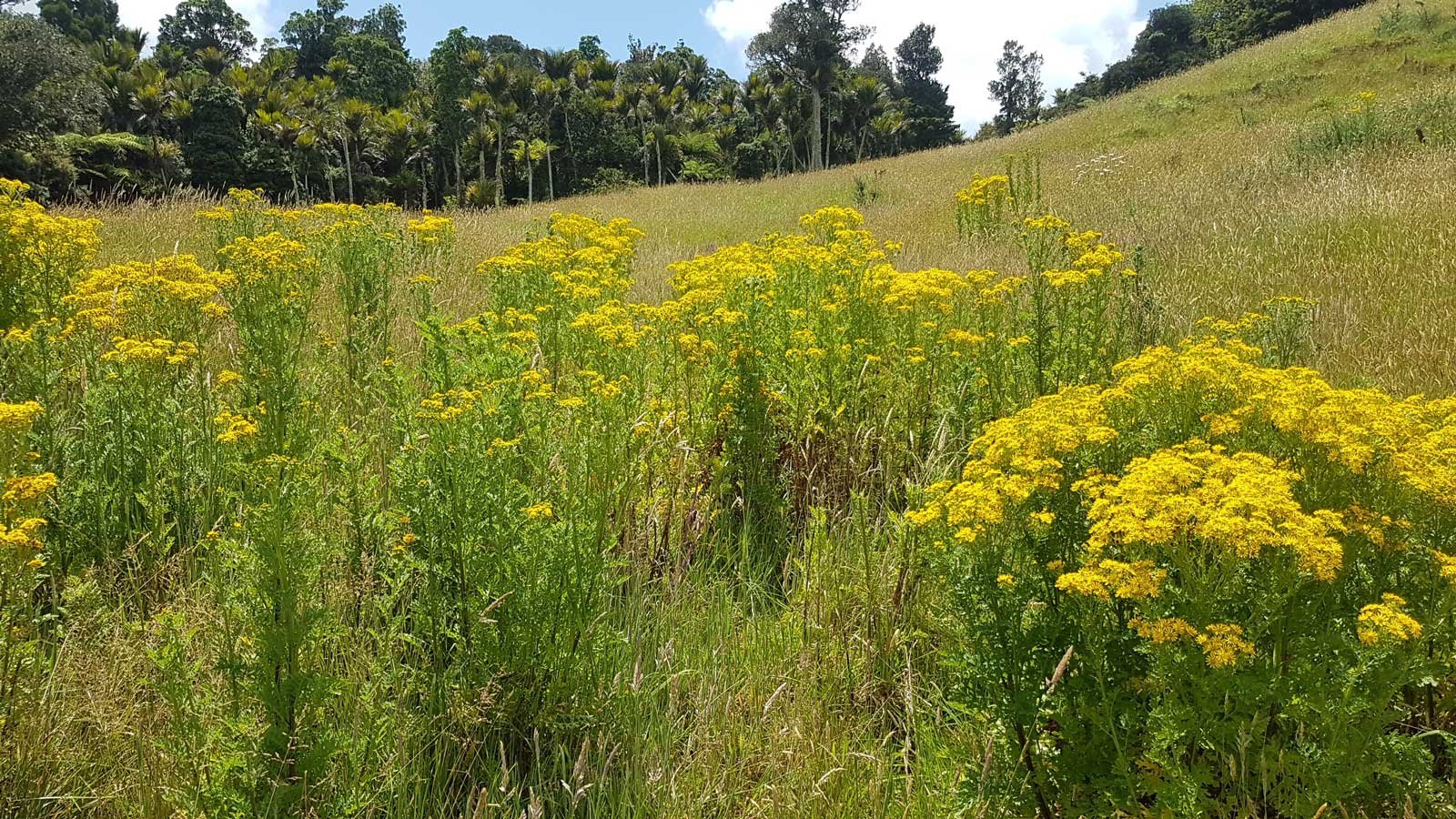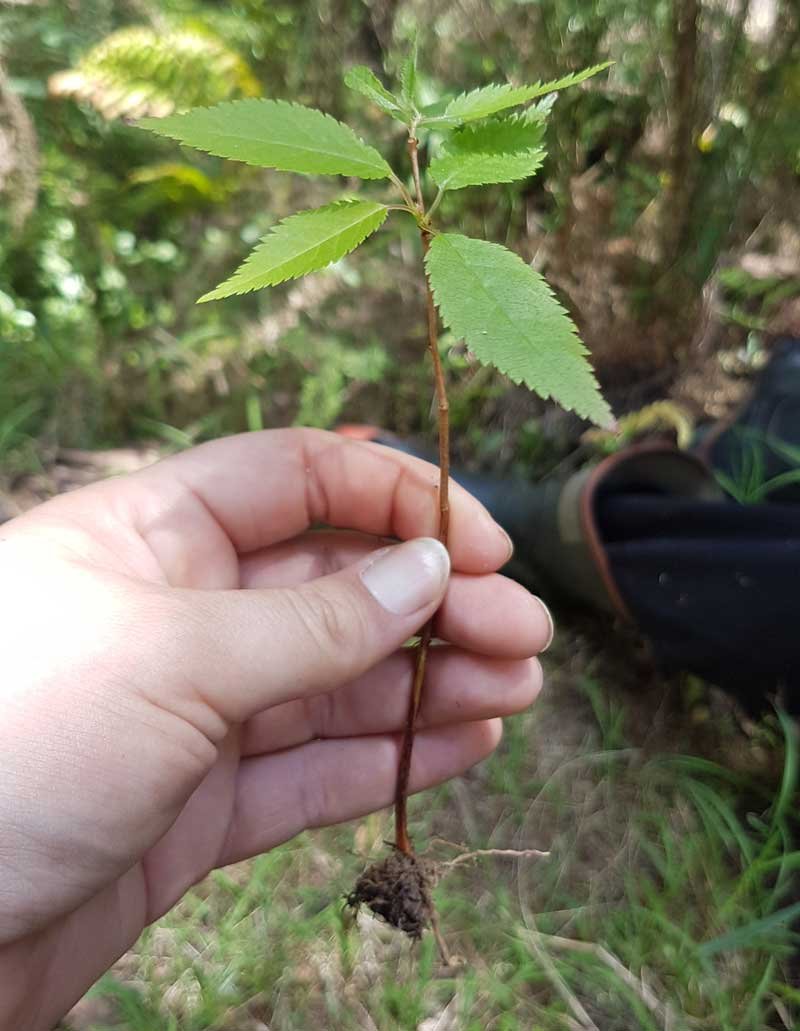In my heart, I am an organic gardener. My first horticultural qualification was in organic horticulture. I use natural cycles and dedicate time and energy to improving the biology below the soil. In my garden, I do a lot of extra physical work to avoid using herbicides in particular.
But… there’s a but. Herbicides, when used appropriately, are tools that can help native species. Sometimes they are necessary to prevent your stock from being poisoned. I’ve always maintained I am open to their use early on to gain control of weed populations.
At Orotere, we have three major weeds: ragwort, chinese privet, and taiwan cherry. I’ve spent a lot of time researching them and I’ve come to the conclusion that for these three weeds, I have no choice but to use herbicide.
Ragwort
Ragwort is a member of the daisy family. It has very pretty yellow flowers that the bees love. It’s also toxic to cows and reproduces quickly and prolifically.
We have quite the ocean of ragwort in flower currently. Getting on top of it as fast as possible is a high priority.
A couple of natural predators for ragwort do exist in New Zealand, but they would take a long time to get our problem under control. And then I’d have to maintain a ragwort population to maintain a population of ragwort control organisms. I’d really rather just get rid of the ragwort.
I could also introduce sheep, who are able to eat ragwort. As much as I’d love a few sheep, that would involve a lot of extra fencing. I’ll absolutely be doing that fencing work in the future, but it makes more sense to do that as we redevelop each paddock. Doing it now would be really expensive and wasteful. Plus I don’t know a thing about sheep yet. It’d be pretty irresponsible to introduce animals I don’t know how to look after.
Grubbing them from the ground is no help. They will resprout from the fibourous roots – meaning instead of one ragwort plant, you now have 10. Worse, when you do this, those 10 new plants become even harder to kill.
One of the most important aspects of ragwort control is keeping it from going to flower. Or if it does go to flower, preventing it from going to seed. The seeds can still mature after removal, so it’s important to either dump the flowers at a green waste disposal, or burn them. Composting at home or letting them rot in the field will only give you more ragwort in the future.
That’s been my major task this week: removing ragwort flowers, sealing them in 50l rubbish bins, lugging those bins up the hill and taking them to the green waste disposal yard. I’ve taken out 6 bins already and the job isn’t finished yet.


Once the flowers are removed, we spray them with a mix of metsulfuron-methyl, organo silicone, and a dye. The dye is entirely non-toxic but helps us see where we’ve been so we don’t over-spray. We use a backpack sprayer with a wand to ensure we are only getting the plants we intend to kill.
Taiwan cherry
Taiwan cherry is a beautiful tree. The tūi love it. Unfortunately it’s also fast-growing and quickly-spread by birds. The first couple of times I visited this property, I didn’t see them.
But after all the forms were signed and the deposit was paid, we drove up before taking possession to take a look around. It was July, it was miserable and raining. The first thing I noticed were the pink blossoms lighting up the valley. Taiwan cherry is taking over parts of the bush.

The previous owner of the property did a lot of work on the cherry. There are chopped branches all over the place. We’ve used a lot of the wood constructing the luffa garden. They pulled down as many as they could reach. It’s truly astonishing to see how much work has been done.
Unfortunately, just chopping down a cherry tree isn’t enough to kill it. All of those trees have turned into coppiced bushes. Which means we now have to follow their footsteps, find every cherry bush, and poison it. The reproduction has been slowed, but if we don’t get to them this summer, they’ll be in blossom again next winter.
Again, we’re using metsulfuron-methyl, this time mixed with glyphosate. We remove the living plant matter and paint the stump with the poison. This stops them growing back, and ensures the poison is targeted to the problem tree.

Once the adult trees are all located and dealt to, then the yearly task becomes removing juvenile trees and seedlings.
This is a much easier job, achieved by yanking them from the soil in an entirely organic fashion. We’re already doing this religiously as we enjoy the bush.
Chinese privet
Chinese privet is harder to kill than taiwan cherry, but thankfully not as prevalent. Any part of it left on the ground will re-sprout. Even exposed roots will re-sprout unless we specifically poison those as well. Chinese privet would happily fill the gaps left by the cherry if we allowed it to, so it’s important to control both.
Most of our privet has been controlled already, but not poisoned. So while we’re out doing the cherry, we’ll hit the privet with the same formula and method, making sure to take the wood away for dumping.
Making the choice
For the sake of our native plants, our stock, and our sanity we’ve had to make a choice.
It’s easy to just spray out everything. It’s much harder to selectively apply the right poisons only when required. We have gorse that will be safe from sprays. Gorse isn’t that bad. It has a deep tap-root which helps hold slopes together, fixes nitrogen to the soil, and feeds the bees when there’s not much food around. The worst of it is gorse hurts when it pricks you, and it makes a lot of seeds. Because gorse can be effectively removed organically, I’m not worried about it.
But sometimes, you’ve just got to declare (rag)war.
I’ll only use herbicide where absolutely required. Our property has a written weed control plan, and I’m tracking what we are using. The goal is to hit everything properly with the recommended products at the recommended dose at the recommended time. It will only apply to particularly stubborn, poisonous, or invasive weeds. We’ll review it annually, and hopefully it will make itself obsolete within 3 years.
I don’t want to poison this land, but our native species have not evolved to compete with some of the things that have been introduced. To give them a chance, I’ve made a choice. I hope it proves to be the right one.



